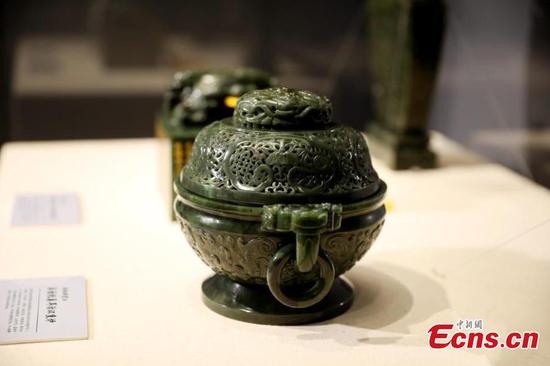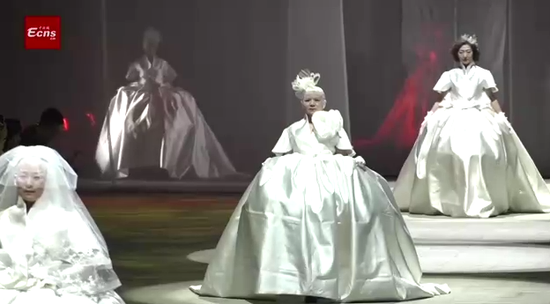
Wang Junzi exchanges with his apprentice Song Zhaobing on the traditional firing skills of Ru porcelain at the heritage site of Ru porcelain kiln in Qingliangsi Village, Baofeng County of central China's Henan Province, May 8, 2019. Ru porcelain, one of the five famous kinds of porcelains during the Song Dynasty (960-1279) in ancient China, is known for its azure color, light body, filmy grain and gentle textile. Wang Junzi, born in 1960, is a Ru porcelain firing craftsman in Qingliangsi Village of Baofeng County in central China's Henan, where the ancient official Ru porcelain kiln in Song Dynasty is located. In order to reproduce the beauty of "celestial blue" of Ru porcelain, Wang Junzi has devoted himself to tackling the key problems for more than 30 years. Influenced by his family and the culture of Ru porcelain, Wang Junzi has devoted himself to studying Ru porcelain since young. In order to solve a series of technical problems such as the preparation of azure glaze, Wang Junzi went to many porcelain producing places for advice, and through thousands of experiments, finally grasped the key technology of Ru porcelain firing and formed unique technical characteristics. Now he has gained the unique skills of Ru porcelain firing and has become the representative inheritor of firing skills of Ru porcelain, a national intangible cultural heritage. In order to carry forward the culture of Ru porcelain and inherit its skills, Wang Junzi has successively accepted nearly 20 apprentices since 2003. He has taught young people the traditional technological processes and methods of firing Ru porcelain, such as manual casting, glaze ingredients preparing, glazing and firing. With his efforts, Ru porcelain culture has become a symbol for the development of local cultural industry. "My dream is to recover, pass on and carry forward the art of firing Ru porcelain." Said Wang Junzi. (Xinhua/Li An)
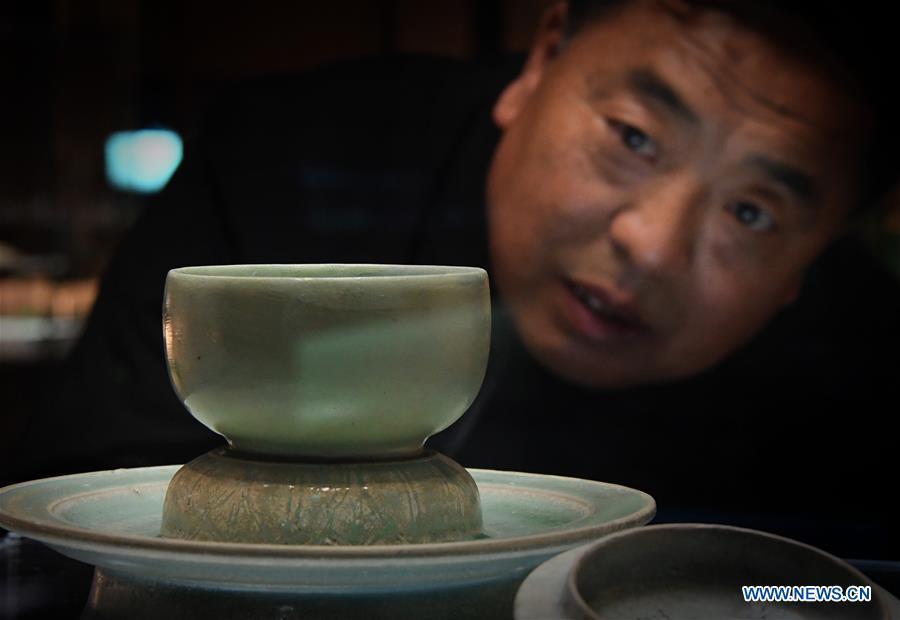
Wang Junzi exchanges with his apprentice Song Zhaobing on the traditional firing skills of Ru porcelain at the heritage site of Ru porcelain kiln in Qingliangsi Village, Baofeng County of central China's Henan Province, May 8, 2019. Ru porcelain, one of the five famous kinds of porcelains during the Song Dynasty (960-1279) in ancient China, is known for its azure color, light body, filmy grain and gentle textile. Wang Junzi, born in 1960, is a Ru porcelain firing craftsman in Qingliangsi Village of Baofeng County in central China's Henan, where the ancient official Ru porcelain kiln in Song Dynasty is located. In order to reproduce the beauty of "celestial blue" of Ru porcelain, Wang Junzi has devoted himself to tackling the key problems for more than 30 years. Influenced by his family and the culture of Ru porcelain, Wang Junzi has devoted himself to studying Ru porcelain since young. In order to solve a series of technical problems such as the preparation of azure glaze, Wang Junzi went to many porcelain producing places for advice, and through thousands of experiments, finally grasped the key technology of Ru porcelain firing and formed unique technical characteristics. Now he has gained the unique skills of Ru porcelain firing and has become the representative inheritor of firing skills of Ru porcelain, a national intangible cultural heritage. In order to carry forward the culture of Ru porcelain and inherit its skills, Wang Junzi has successively accepted nearly 20 apprentices since 2003. He has taught young people the traditional technological processes and methods of firing Ru porcelain, such as manual casting, glaze ingredients preparing, glazing and firing. With his efforts, Ru porcelain culture has become a symbol for the development of local cultural industry. "My dream is to recover, pass on and carry forward the art of firing Ru porcelain." Said Wang Junzi. (Xinhua/Li An)
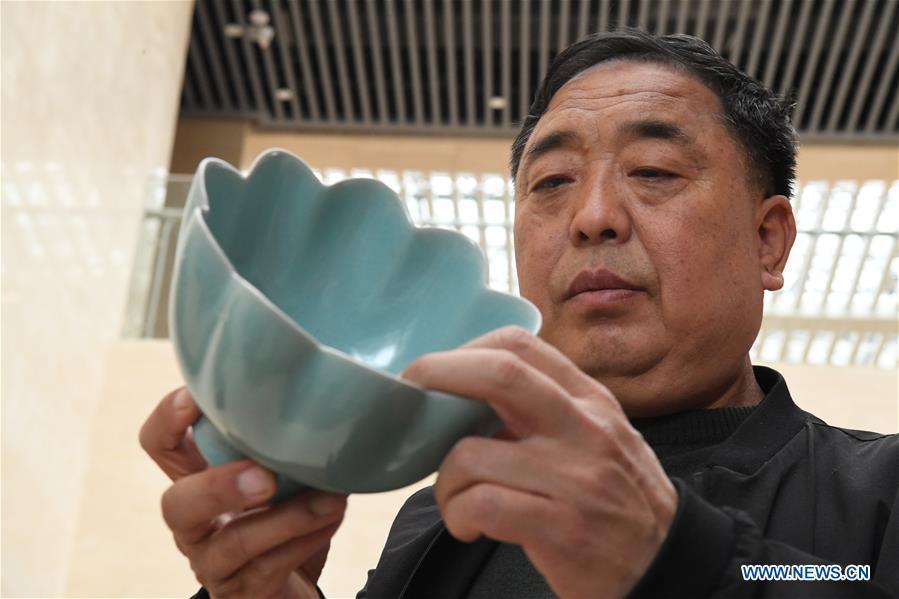
Wang Junzi checks a Ru porcelain work he made at a Ru porcelain museum in Baofeng County of central China's Henan Province, May 8, 2019. Ru porcelain, one of the five famous kinds of porcelains during the Song Dynasty (960-1279) in ancient China, is known for its azure color, light body, filmy grain and gentle textile. Wang Junzi, born in 1960, is a Ru porcelain firing craftsman in Qingliangsi Village of Baofeng County in central China's Henan, where the ancient official Ru porcelain kiln in Song Dynasty is located. In order to reproduce the beauty of "celestial blue" of Ru porcelain, Wang Junzi has devoted himself to tackling the key problems for more than 30 years. Influenced by his family and the culture of Ru porcelain, Wang Junzi has devoted himself to studying Ru porcelain since young. In order to solve a series of technical problems such as the preparation of azure glaze, Wang Junzi went to many porcelain producing places for advice, and through thousands of experiments, finally grasped the key technology of Ru porcelain firing and formed unique technical characteristics. Now he has gained the unique skills of Ru porcelain firing and has become the representative inheritor of firing skills of Ru porcelain, a national intangible cultural heritage. In order to carry forward the culture of Ru porcelain and inherit its skills, Wang Junzi has successively accepted nearly 20 apprentices since 2003. He has taught young people the traditional technological processes and methods of firing Ru porcelain, such as manual casting, glaze ingredients preparing, glazing and firing. With his efforts, Ru porcelain culture has become a symbol for the development of local cultural industry. "My dream is to recover, pass on and carry forward the art of firing Ru porcelain." Said Wang Junzi. (Xinhua/Li An)
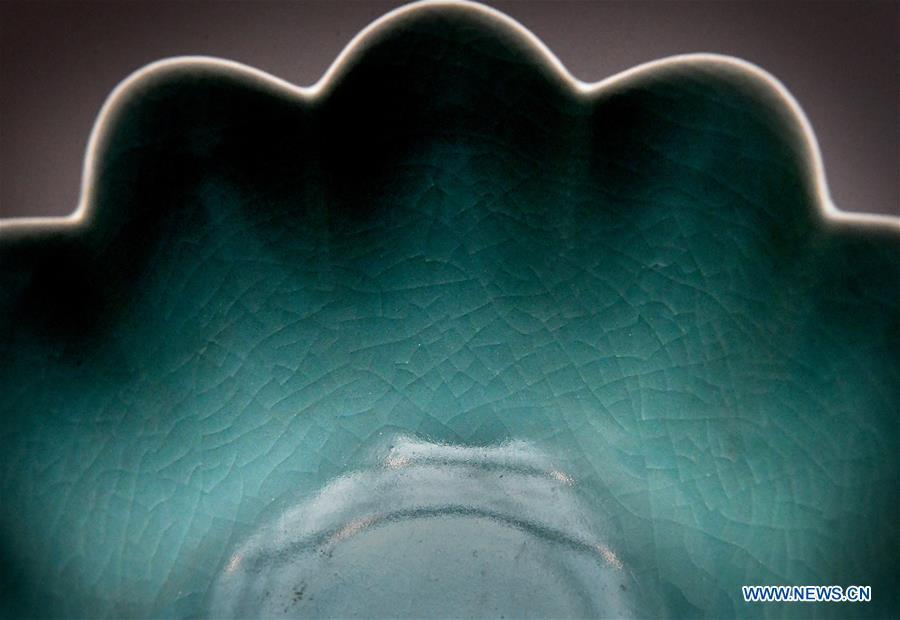
Photo taken on May 8, 2019 shows part of a Ru porcelain work made by Wang Junzi in Qingliangsi Village, Baofeng County of central China's Henan Province. Ru porcelain, one of the five famous kinds of porcelains during the Song Dynasty (960-1279) in ancient China, is known for its azure color, light body, filmy grain and gentle textile. Wang Junzi, born in 1960, is a Ru porcelain firing craftsman in Qingliangsi Village of Baofeng County in central China's Henan, where the ancient official Ru porcelain kiln in Song Dynasty is located. In order to reproduce the beauty of "celestial blue" of Ru porcelain, Wang Junzi has devoted himself to tackling the key problems for more than 30 years. Influenced by his family and the culture of Ru porcelain, Wang Junzi has devoted himself to studying Ru porcelain since young. In order to solve a series of technical problems such as the preparation of azure glaze, Wang Junzi went to many porcelain producing places for advice, and through thousands of experiments, finally grasped the key technology of Ru porcelain firing and formed unique technical characteristics. Now he has gained the unique skills of Ru porcelain firing and has become the representative inheritor of firing skills of Ru porcelain, a national intangible cultural heritage. In order to carry forward the culture of Ru porcelain and inherit its skills, Wang Junzi has successively accepted nearly 20 apprentices since 2003. He has taught young people the traditional technological processes and methods of firing Ru porcelain, such as manual casting, glaze ingredients preparing, glazing and firing. With his efforts, Ru porcelain culture has become a symbol for the development of local cultural industry. "My dream is to recover, pass on and carry forward the art of firing Ru porcelain." Said Wang Junzi. (Xinhua/Li An)
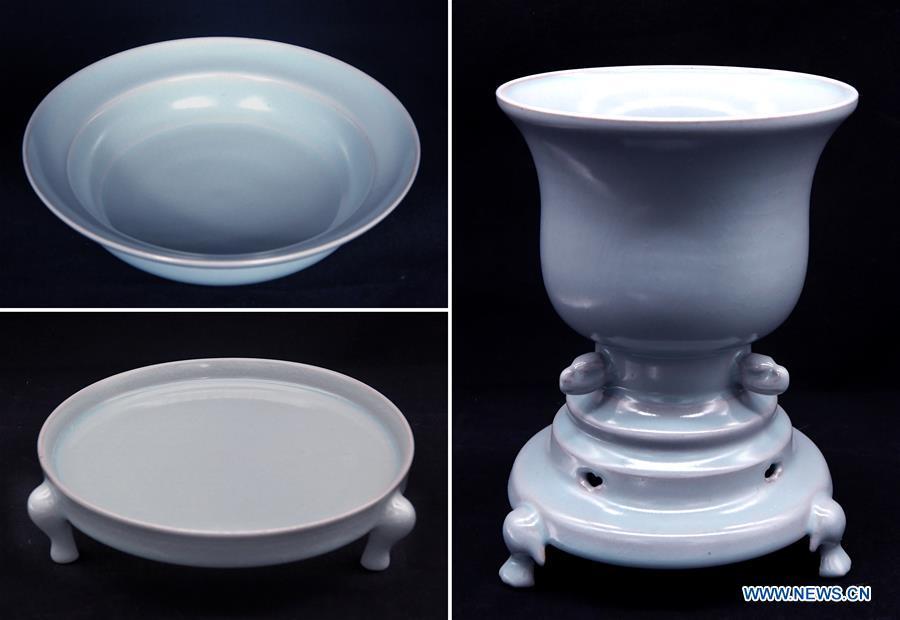
The combination photo taken on May 8, 2019 shows Ru porcelain works made by Wang Junzi in Qingliangsi Village, Baofeng County of central China's Henan Province. Ru porcelain, one of the five famous kinds of porcelains during the Song Dynasty (960-1279) in ancient China, is known for its azure color, light body, filmy grain and gentle textile. Wang Junzi, born in 1960, is a Ru porcelain firing craftsman in Qingliangsi Village of Baofeng County in central China's Henan, where the ancient official Ru porcelain kiln in Song Dynasty is located. In order to reproduce the beauty of "celestial blue" of Ru porcelain, Wang Junzi has devoted himself to tackling the key problems for more than 30 years. Influenced by his family and the culture of Ru porcelain, Wang Junzi has devoted himself to studying Ru porcelain since young. In order to solve a series of technical problems such as the preparation of azure glaze, Wang Junzi went to many porcelain producing places for advice, and through thousands of experiments, finally grasped the key technology of Ru porcelain firing and formed unique technical characteristics. Now he has gained the unique skills of Ru porcelain firing and has become the representative inheritor of firing skills of Ru porcelain, a national intangible cultural heritage. In order to carry forward the culture of Ru porcelain and inherit its skills, Wang Junzi has successively accepted nearly 20 apprentices since 2003. He has taught young people the traditional technological processes and methods of firing Ru porcelain, such as manual casting, glaze ingredients preparing, glazing and firing. With his efforts, Ru porcelain culture has become a symbol for the development of local cultural industry. "My dream is to recover, pass on and carry forward the art of firing Ru porcelain." Said Wang Junzi. (Xinhua/Li An)
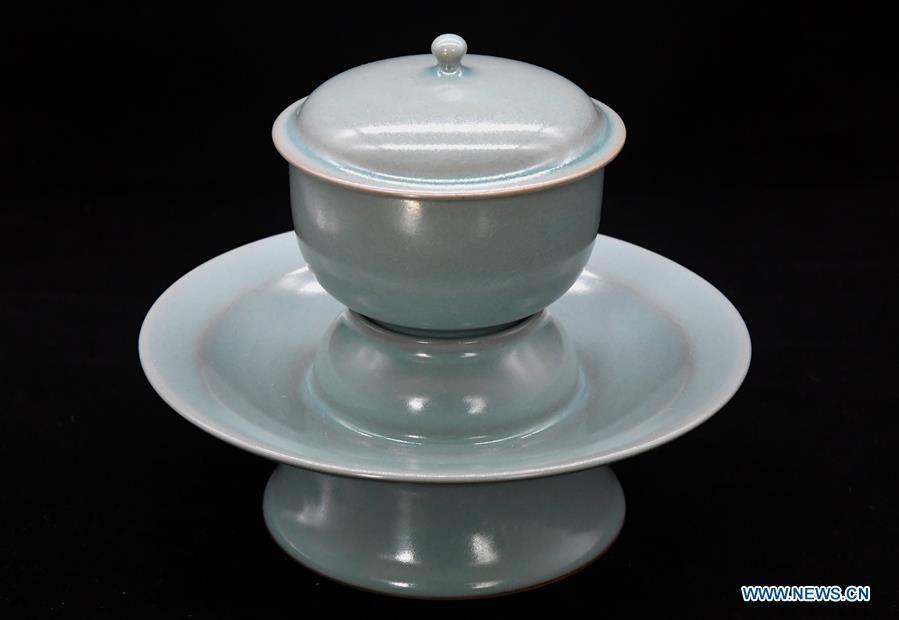
Photo taken on May 8, 2019 shows a Ru porcelain work made by Wang Junzi in Qingliangsi Village, Baofeng County of central China's Henan Province. Ru porcelain, one of the five famous kinds of porcelains during the Song Dynasty (960-1279) in ancient China, is known for its azure color, light body, filmy grain and gentle textile. Wang Junzi, born in 1960, is a Ru porcelain firing craftsman in Qingliangsi Village of Baofeng County in central China's Henan, where the ancient official Ru porcelain kiln in Song Dynasty is located. In order to reproduce the beauty of "celestial blue" of Ru porcelain, Wang Junzi has devoted himself to tackling the key problems for more than 30 years. Influenced by his family and the culture of Ru porcelain, Wang Junzi has devoted himself to studying Ru porcelain since young. In order to solve a series of technical problems such as the preparation of azure glaze, Wang Junzi went to many porcelain producing places for advice, and through thousands of experiments, finally grasped the key technology of Ru porcelain firing and formed unique technical characteristics. Now he has gained the unique skills of Ru porcelain firing and has become the representative inheritor of firing skills of Ru porcelain, a national intangible cultural heritage. In order to carry forward the culture of Ru porcelain and inherit its skills, Wang Junzi has successively accepted nearly 20 apprentices since 2003. He has taught young people the traditional technological processes and methods of firing Ru porcelain, such as manual casting, glaze ingredients preparing, glazing and firing. With his efforts, Ru porcelain culture has become a symbol for the development of local cultural industry. "My dream is to recover, pass on and carry forward the art of firing Ru porcelain." Said Wang Junzi. (Xinhua/Li An)
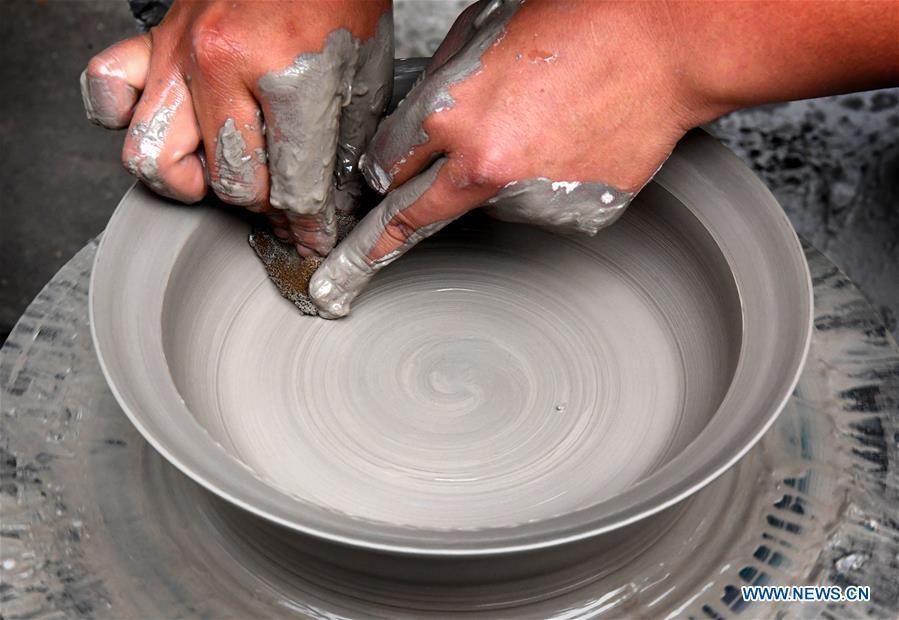
Wang Yaole, an apprentice of Wang Junzi, makes a Ru porcelain work in Qingliangsi Village, Baofeng County of central China's Henan Province, May 8, 2019. Ru porcelain, one of the five famous kinds of porcelains during the Song Dynasty (960-1279) in ancient China, is known for its azure color, light body, filmy grain and gentle textile. Wang Junzi, born in 1960, is a Ru porcelain firing craftsman in Qingliangsi Village of Baofeng County in central China's Henan, where the ancient official Ru porcelain kiln in Song Dynasty is located. In order to reproduce the beauty of "celestial blue" of Ru porcelain, Wang Junzi has devoted himself to tackling the key problems for more than 30 years. Influenced by his family and the culture of Ru porcelain, Wang Junzi has devoted himself to studying Ru porcelain since young. In order to solve a series of technical problems such as the preparation of azure glaze, Wang Junzi went to many porcelain producing places for advice, and through thousands of experiments, finally grasped the key technology of Ru porcelain firing and formed unique technical characteristics. Now he has gained the unique skills of Ru porcelain firing and has become the representative inheritor of firing skills of Ru porcelain, a national intangible cultural heritage. In order to carry forward the culture of Ru porcelain and inherit its skills, Wang Junzi has successively accepted nearly 20 apprentices since 2003. He has taught young people the traditional technological processes and methods of firing Ru porcelain, such as manual casting, glaze ingredients preparing, glazing and firing. With his efforts, Ru porcelain culture has become a symbol for the development of local cultural industry. "My dream is to recover, pass on and carry forward the art of firing Ru porcelain." Said Wang Junzi. (Xinhua/Li An)
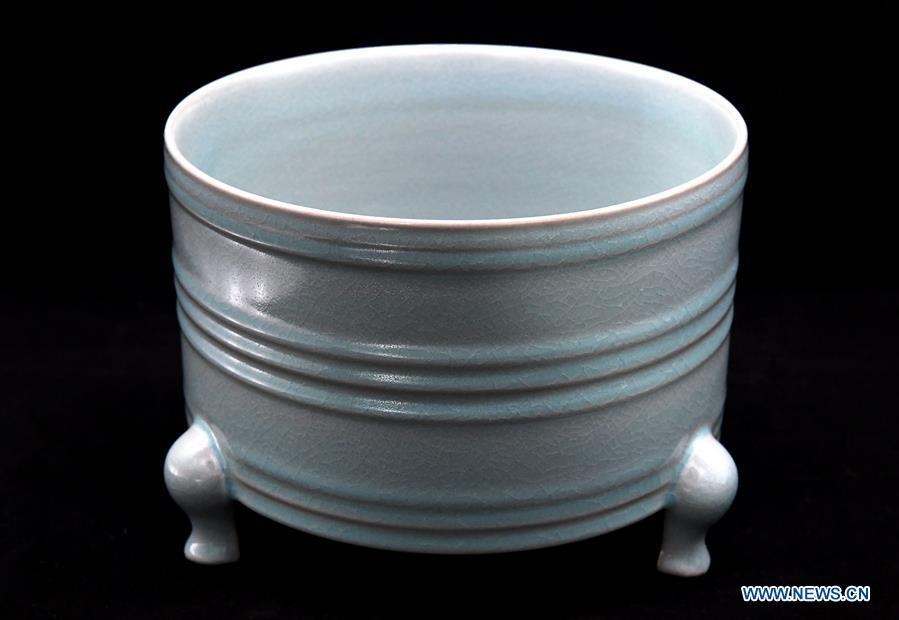
Photo taken on May 8, 2019 shows a Ru porcelain work made by Wang Junzi in Qingliangsi Village, Baofeng County of central China's Henan Province. Ru porcelain, one of the five famous kinds of porcelains during the Song Dynasty (960-1279) in ancient China, is known for its azure color, light body, filmy grain and gentle textile. Wang Junzi, born in 1960, is a Ru porcelain firing craftsman in Qingliangsi Village of Baofeng County in central China's Henan, where the ancient official Ru porcelain kiln in Song Dynasty is located. In order to reproduce the beauty of "celestial blue" of Ru porcelain, Wang Junzi has devoted himself to tackling the key problems for more than 30 years. Influenced by his family and the culture of Ru porcelain, Wang Junzi has devoted himself to studying Ru porcelain since young. In order to solve a series of technical problems such as the preparation of azure glaze, Wang Junzi went to many porcelain producing places for advice, and through thousands of experiments, finally grasped the key technology of Ru porcelain firing and formed unique technical characteristics. Now he has gained the unique skills of Ru porcelain firing and has become the representative inheritor of firing skills of Ru porcelain, a national intangible cultural heritage. In order to carry forward the culture of Ru porcelain and inherit its skills, Wang Junzi has successively accepted nearly 20 apprentices since 2003. He has taught young people the traditional technological processes and methods of firing Ru porcelain, such as manual casting, glaze ingredients preparing, glazing and firing. With his efforts, Ru porcelain culture has become a symbol for the development of local cultural industry. "My dream is to recover, pass on and carry forward the art of firing Ru porcelain." Said Wang Junzi. (Xinhua/Li An)
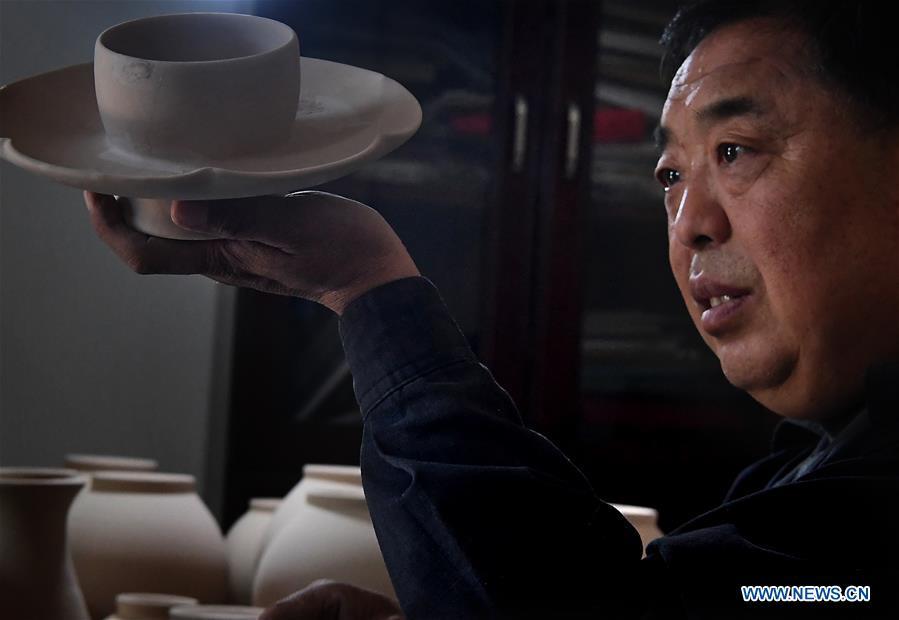
Wang Junzi checks a Ru porcelain work at his studio in Qingliangsi Village, Baofeng County of central China's Henan Province, May 8, 2019. Ru porcelain, one of the five famous kinds of porcelains during the Song Dynasty (960-1279) in ancient China, is known for its azure color, light body, filmy grain and gentle textile. Wang Junzi, born in 1960, is a Ru porcelain firing craftsman in Qingliangsi Village of Baofeng County in central China's Henan, where the ancient official Ru porcelain kiln in Song Dynasty is located. In order to reproduce the beauty of "celestial blue" of Ru porcelain, Wang Junzi has devoted himself to tackling the key problems for more than 30 years. Influenced by his family and the culture of Ru porcelain, Wang Junzi has devoted himself to studying Ru porcelain since young. In order to solve a series of technical problems such as the preparation of azure glaze, Wang Junzi went to many porcelain producing places for advice, and through thousands of experiments, finally grasped the key technology of Ru porcelain firing and formed unique technical characteristics. Now he has gained the unique skills of Ru porcelain firing and has become the representative inheritor of firing skills of Ru porcelain, a national intangible cultural heritage. In order to carry forward the culture of Ru porcelain and inherit its skills, Wang Junzi has successively accepted nearly 20 apprentices since 2003. He has taught young people the traditional technological processes and methods of firing Ru porcelain, such as manual casting, glaze ingredients preparing, glazing and firing. With his efforts, Ru porcelain culture has become a symbol for the development of local cultural industry. "My dream is to recover, pass on and carry forward the art of firing Ru porcelain." Said Wang Junzi. (Xinhua/Li An)
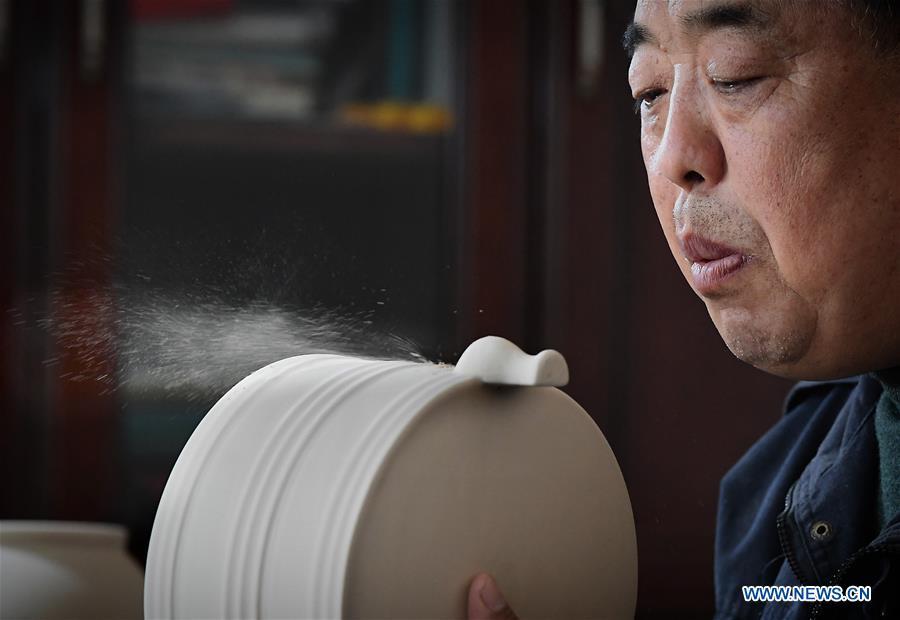
Wang Junzi makes Ru porcelain at his studio in Qingliangsi Village, Baofeng County of central China's Henan Province, May 8, 2019. Ru porcelain, one of the five famous kinds of porcelains during the Song Dynasty (960-1279) in ancient China, is known for its azure color, light body, filmy grain and gentle textile. Wang Junzi, born in 1960, is a Ru porcelain firing craftsman in Qingliangsi Village of Baofeng County in central China's Henan, where the ancient official Ru porcelain kiln in Song Dynasty is located. In order to reproduce the beauty of "celestial blue" of Ru porcelain, Wang Junzi has devoted himself to tackling the key problems for more than 30 years. Influenced by his family and the culture of Ru porcelain, Wang Junzi has devoted himself to studying Ru porcelain since young. In order to solve a series of technical problems such as the preparation of azure glaze, Wang Junzi went to many porcelain producing places for advice, and through thousands of experiments, finally grasped the key technology of Ru porcelain firing and formed unique technical characteristics. Now he has gained the unique skills of Ru porcelain firing and has become the representative inheritor of firing skills of Ru porcelain, a national intangible cultural heritage. In order to carry forward the culture of Ru porcelain and inherit its skills, Wang Junzi has successively accepted nearly 20 apprentices since 2003. He has taught young people the traditional technological processes and methods of firing Ru porcelain, such as manual casting, glaze ingredients preparing, glazing and firing. With his efforts, Ru porcelain culture has become a symbol for the development of local cultural industry. "My dream is to recover, pass on and carry forward the art of firing Ru porcelain." Said Wang Junzi. (Xinhua/Li An)
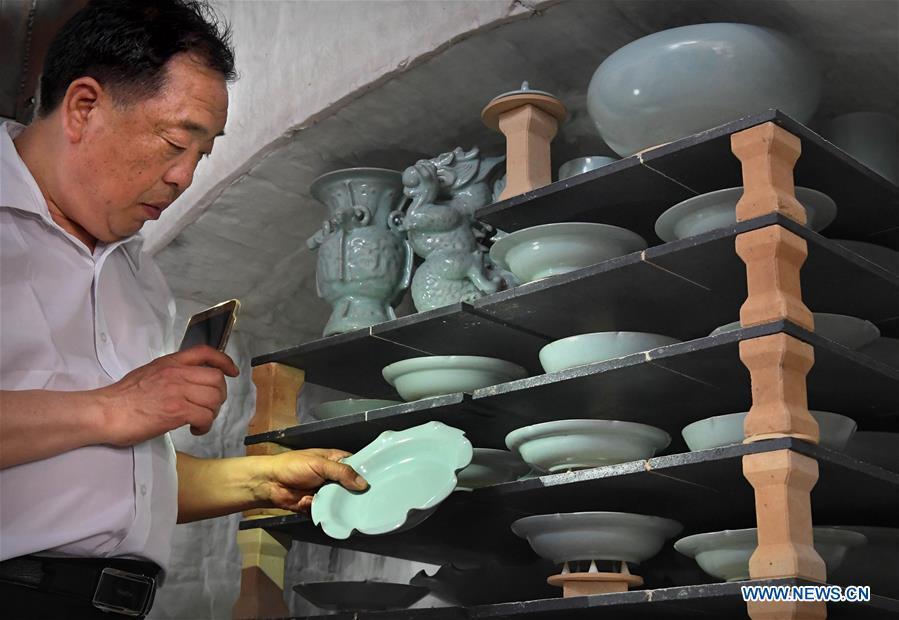
Wang Junzi checks Ru porcelains just fired at his studio in Qingliangsi Village, Baofeng County of central China's Henan Province, May 9, 2019. Ru porcelain, one of the five famous kinds of porcelains during the Song Dynasty (960-1279) in ancient China, is known for its azure color, light body, filmy grain and gentle textile. Wang Junzi, born in 1960, is a Ru porcelain firing craftsman in Qingliangsi Village of Baofeng County in central China's Henan, where the ancient official Ru porcelain kiln in Song Dynasty is located. In order to reproduce the beauty of "celestial blue" of Ru porcelain, Wang Junzi has devoted himself to tackling the key problems for more than 30 years. Influenced by his family and the culture of Ru porcelain, Wang Junzi has devoted himself to studying Ru porcelain since young. In order to solve a series of technical problems such as the preparation of azure glaze, Wang Junzi went to many porcelain producing places for advice, and through thousands of experiments, finally grasped the key technology of Ru porcelain firing and formed unique technical characteristics. Now he has gained the unique skills of Ru porcelain firing and has become the representative inheritor of firing skills of Ru porcelain, a national intangible cultural heritage. In order to carry forward the culture of Ru porcelain and inherit its skills, Wang Junzi has successively accepted nearly 20 apprentices since 2003. He has taught young people the traditional technological processes and methods of firing Ru porcelain, such as manual casting, glaze ingredients preparing, glazing and firing. With his efforts, Ru porcelain culture has become a symbol for the development of local cultural industry. "My dream is to recover, pass on and carry forward the art of firing Ru porcelain." Said Wang Junzi. (Xinhua/Li An)
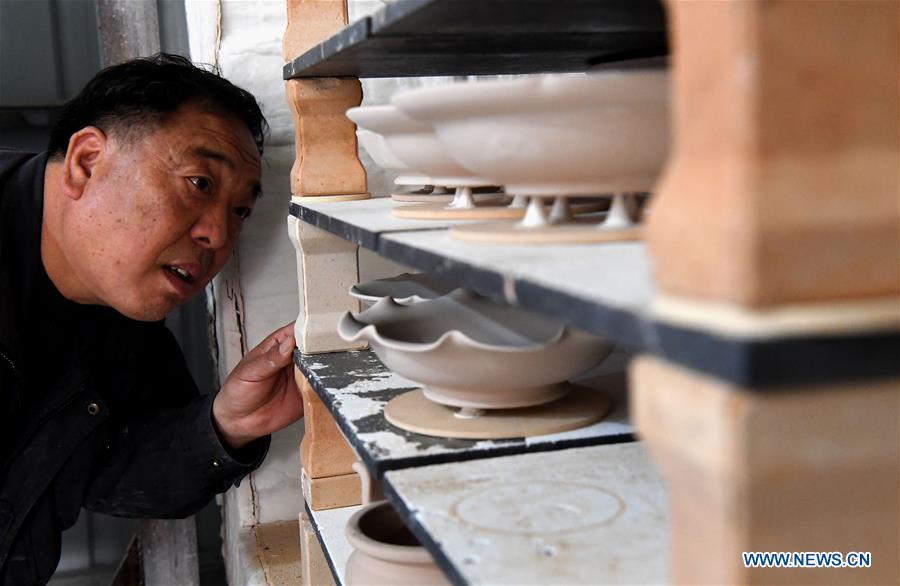
Wang Junzi checks the space of Ru porcelain kiln at his studio in Qingliangsi Village, Baofeng County of central China's Henan Province, May 8, 2019. Ru porcelain, one of the five famous kinds of porcelains during the Song Dynasty (960-1279) in ancient China, is known for its azure color, light body, filmy grain and gentle textile. Wang Junzi, born in 1960, is a Ru porcelain firing craftsman in Qingliangsi Village of Baofeng County in central China's Henan, where the ancient official Ru porcelain kiln in Song Dynasty is located. In order to reproduce the beauty of "celestial blue" of Ru porcelain, Wang Junzi has devoted himself to tackling the key problems for more than 30 years. Influenced by his family and the culture of Ru porcelain, Wang Junzi has devoted himself to studying Ru porcelain since young. In order to solve a series of technical problems such as the preparation of azure glaze, Wang Junzi went to many porcelain producing places for advice, and through thousands of experiments, finally grasped the key technology of Ru porcelain firing and formed unique technical characteristics. Now he has gained the unique skills of Ru porcelain firing and has become the representative inheritor of firing skills of Ru porcelain, a national intangible cultural heritage. In order to carry forward the culture of Ru porcelain and inherit its skills, Wang Junzi has successively accepted nearly 20 apprentices since 2003. He has taught young people the traditional technological processes and methods of firing Ru porcelain, such as manual casting, glaze ingredients preparing, glazing and firing. With his efforts, Ru porcelain culture has become a symbol for the development of local cultural industry. "My dream is to recover, pass on and carry forward the art of firing Ru porcelain." Said Wang Junzi. (Xinhua/Li An)
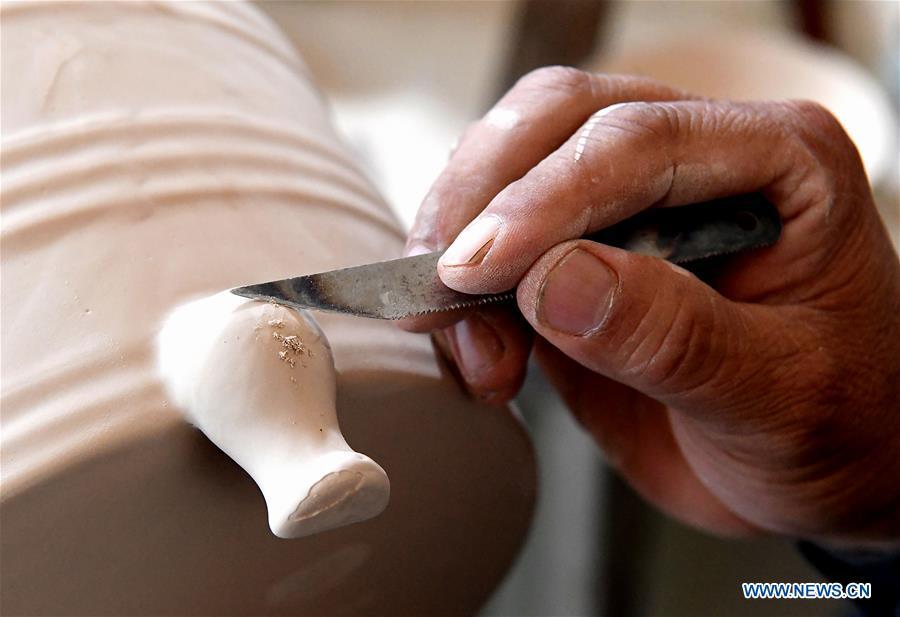
Wang Junzi makes a Ru porcelain work at his studio in Qingliangsi Village, Baofeng County of central China's Henan Province, May 8, 2019. Ru porcelain, one of the five famous kinds of porcelains during the Song Dynasty (960-1279) in ancient China, is known for its azure color, light body, filmy grain and gentle textile. Wang Junzi, born in 1960, is a Ru porcelain firing craftsman in Qingliangsi Village of Baofeng County in central China's Henan, where the ancient official Ru porcelain kiln in Song Dynasty is located. In order to reproduce the beauty of "celestial blue" of Ru porcelain, Wang Junzi has devoted himself to tackling the key problems for more than 30 years. Influenced by his family and the culture of Ru porcelain, Wang Junzi has devoted himself to studying Ru porcelain since young. In order to solve a series of technical problems such as the preparation of azure glaze, Wang Junzi went to many porcelain producing places for advice, and through thousands of experiments, finally grasped the key technology of Ru porcelain firing and formed unique technical characteristics. Now he has gained the unique skills of Ru porcelain firing and has become the representative inheritor of firing skills of Ru porcelain, a national intangible cultural heritage. In order to carry forward the culture of Ru porcelain and inherit its skills, Wang Junzi has successively accepted nearly 20 apprentices since 2003. He has taught young people the traditional technological processes and methods of firing Ru porcelain, such as manual casting, glaze ingredients preparing, glazing and firing. With his efforts, Ru porcelain culture has become a symbol for the development of local cultural industry. "My dream is to recover, pass on and carry forward the art of firing Ru porcelain." Said Wang Junzi. (Xinhua/Li An)
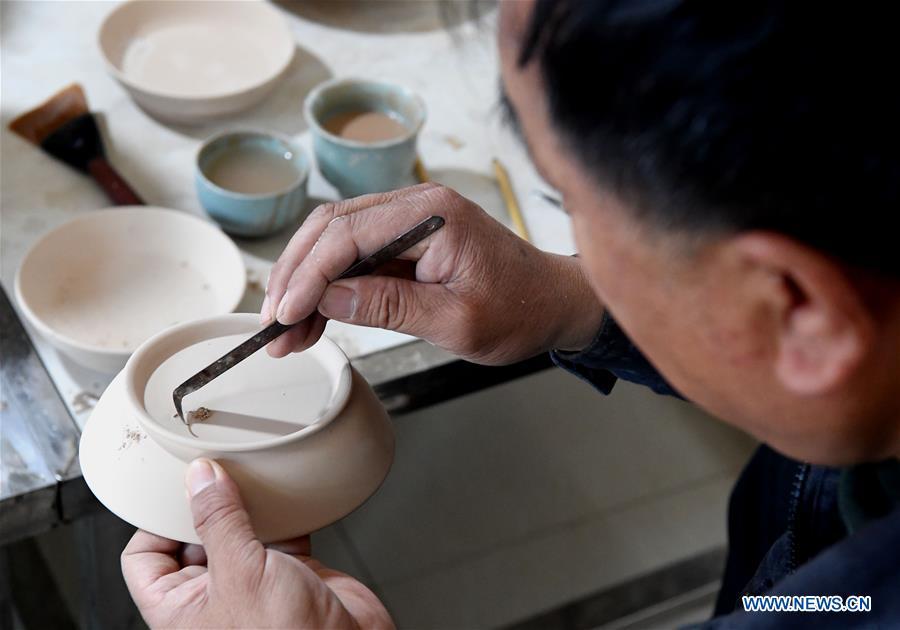
Wang Junzi makes a Ru porcelain work at his studio in Qingliangsi Village, Baofeng County of central China's Henan Province, May 8, 2019. Ru porcelain, one of the five famous kinds of porcelains during the Song Dynasty (960-1279) in ancient China, is known for its azure color, light body, filmy grain and gentle textile. Wang Junzi, born in 1960, is a Ru porcelain firing craftsman in Qingliangsi Village of Baofeng County in central China's Henan, where the ancient official Ru porcelain kiln in Song Dynasty is located. In order to reproduce the beauty of "celestial blue" of Ru porcelain, Wang Junzi has devoted himself to tackling the key problems for more than 30 years. Influenced by his family and the culture of Ru porcelain, Wang Junzi has devoted himself to studying Ru porcelain since young. In order to solve a series of technical problems such as the preparation of azure glaze, Wang Junzi went to many porcelain producing places for advice, and through thousands of experiments, finally grasped the key technology of Ru porcelain firing and formed unique technical characteristics. Now he has gained the unique skills of Ru porcelain firing and has become the representative inheritor of firing skills of Ru porcelain, a national intangible cultural heritage. In order to carry forward the culture of Ru porcelain and inherit its skills, Wang Junzi has successively accepted nearly 20 apprentices since 2003. He has taught young people the traditional technological processes and methods of firing Ru porcelain, such as manual casting, glaze ingredients preparing, glazing and firing. With his efforts, Ru porcelain culture has become a symbol for the development of local cultural industry. "My dream is to recover, pass on and carry forward the art of firing Ru porcelain." Said Wang Junzi. (Xinhua/Li An)
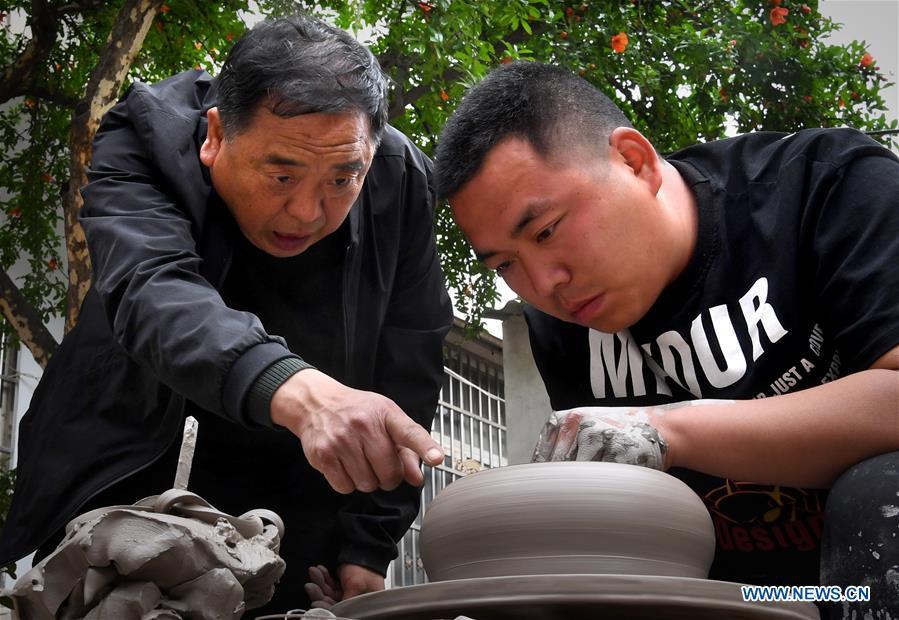
Wang Junzi guides his apprentice Wang Yaole at his studio in Qingliangsi Village, Baofeng County of central China's Henan Province, May 8, 2019. Ru porcelain, one of the five famous kinds of porcelains during the Song Dynasty (960-1279) in ancient China, is known for its azure color, light body, filmy grain and gentle textile. Wang Junzi, born in 1960, is a Ru porcelain firing craftsman in Qingliangsi Village of Baofeng County in central China's Henan, where the ancient official Ru porcelain kiln in Song Dynasty is located. In order to reproduce the beauty of "celestial blue" of Ru porcelain, Wang Junzi has devoted himself to tackling the key problems for more than 30 years. Influenced by his family and the culture of Ru porcelain, Wang Junzi has devoted himself to studying Ru porcelain since young. In order to solve a series of technical problems such as the preparation of azure glaze, Wang Junzi went to many porcelain producing places for advice, and through thousands of experiments, finally grasped the key technology of Ru porcelain firing and formed unique technical characteristics. Now he has gained the unique skills of Ru porcelain firing and has become the representative inheritor of firing skills of Ru porcelain, a national intangible cultural heritage. In order to carry forward the culture of Ru porcelain and inherit its skills, Wang Junzi has successively accepted nearly 20 apprentices since 2003. He has taught young people the traditional technological processes and methods of firing Ru porcelain, such as manual casting, glaze ingredients preparing, glazing and firing. With his efforts, Ru porcelain culture has become a symbol for the development of local cultural industry. "My dream is to recover, pass on and carry forward the art of firing Ru porcelain." Said Wang Junzi. (Xinhua/Li An)
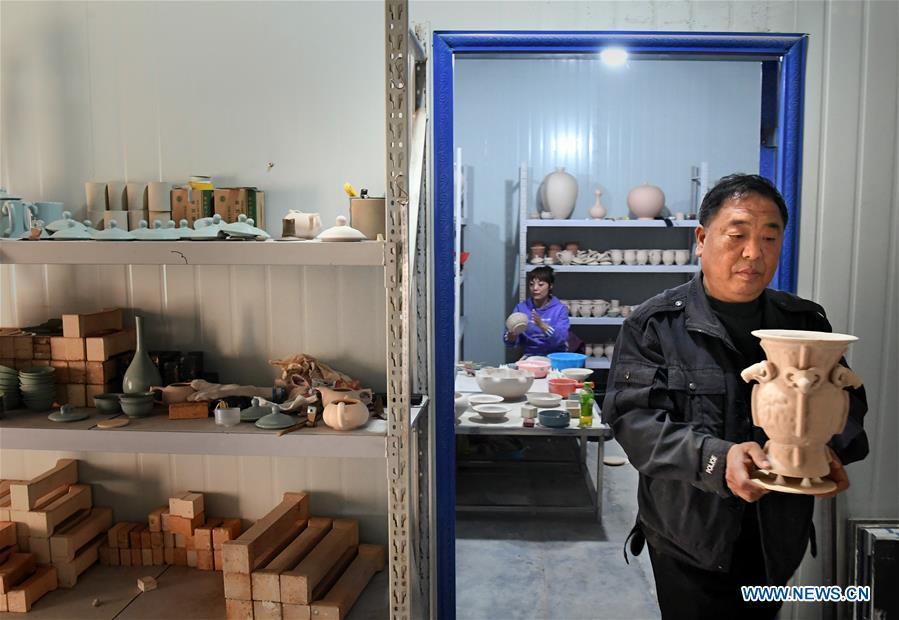
Wang Junzi carries a semi-finished Ru porcelain work to kiln at his studio in Qingliangsi Village, Baofeng County of central China's Henan Province, May 8, 2019. Ru porcelain, one of the five famous kinds of porcelains during the Song Dynasty (960-1279) in ancient China, is known for its azure color, light body, filmy grain and gentle textile. Wang Junzi, born in 1960, is a Ru porcelain firing craftsman in Qingliangsi Village of Baofeng County in central China's Henan, where the ancient official Ru porcelain kiln in Song Dynasty is located. In order to reproduce the beauty of "celestial blue" of Ru porcelain, Wang Junzi has devoted himself to tackling the key problems for more than 30 years. Influenced by his family and the culture of Ru porcelain, Wang Junzi has devoted himself to studying Ru porcelain since young. In order to solve a series of technical problems such as the preparation of azure glaze, Wang Junzi went to many porcelain producing places for advice, and through thousands of experiments, finally grasped the key technology of Ru porcelain firing and formed unique technical characteristics. Now he has gained the unique skills of Ru porcelain firing and has become the representative inheritor of firing skills of Ru porcelain, a national intangible cultural heritage. In order to carry forward the culture of Ru porcelain and inherit its skills, Wang Junzi has successively accepted nearly 20 apprentices since 2003. He has taught young people the traditional technological processes and methods of firing Ru porcelain, such as manual casting, glaze ingredients preparing, glazing and firing. With his efforts, Ru porcelain culture has become a symbol for the development of local cultural industry. "My dream is to recover, pass on and carry forward the art of firing Ru porcelain." Said Wang Junzi. (Xinhua/Li An)
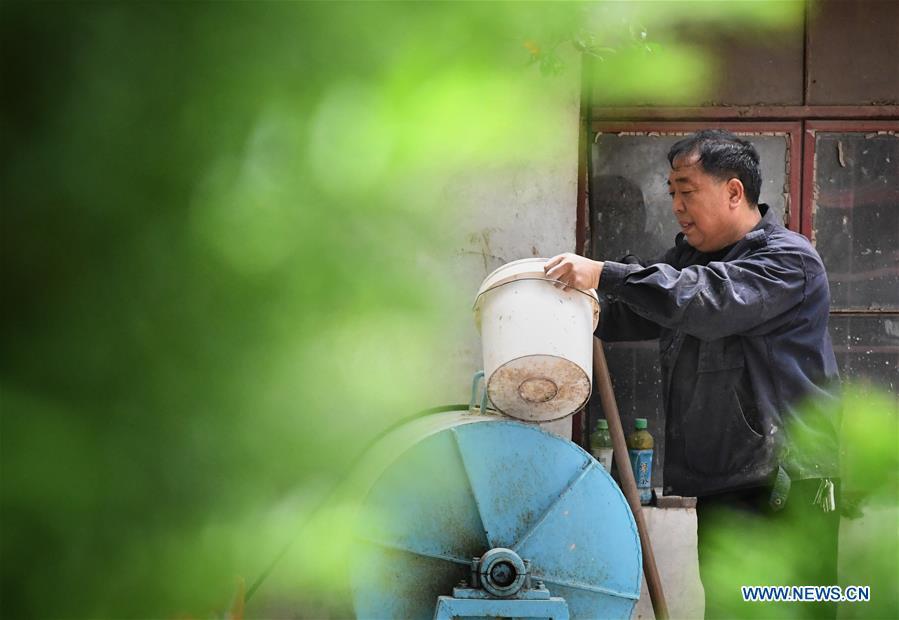
Wang Junzi prepares Ru porcelain glaze at his studio in Qingliangsi Village, Baofeng County of central China's Henan Province, May 8, 2019. Ru porcelain, one of the five famous kinds of porcelains during the Song Dynasty (960-1279) in ancient China, is known for its azure color, light body, filmy grain and gentle textile. Wang Junzi, born in 1960, is a Ru porcelain firing craftsman in Qingliangsi Village of Baofeng County in central China's Henan, where the ancient official Ru porcelain kiln in Song Dynasty is located. In order to reproduce the beauty of "celestial blue" of Ru porcelain, Wang Junzi has devoted himself to tackling the key problems for more than 30 years. Influenced by his family and the culture of Ru porcelain, Wang Junzi has devoted himself to studying Ru porcelain since young. In order to solve a series of technical problems such as the preparation of azure glaze, Wang Junzi went to many porcelain producing places for advice, and through thousands of experiments, finally grasped the key technology of Ru porcelain firing and formed unique technical characteristics. Now he has gained the unique skills of Ru porcelain firing and has become the representative inheritor of firing skills of Ru porcelain, a national intangible cultural heritage. In order to carry forward the culture of Ru porcelain and inherit its skills, Wang Junzi has successively accepted nearly 20 apprentices since 2003. He has taught young people the traditional technological processes and methods of firing Ru porcelain, such as manual casting, glaze ingredients preparing, glazing and firing. With his efforts, Ru porcelain culture has become a symbol for the development of local cultural industry. "My dream is to recover, pass on and carry forward the art of firing Ru porcelain." Said Wang Junzi. (Xinhua/Li An)
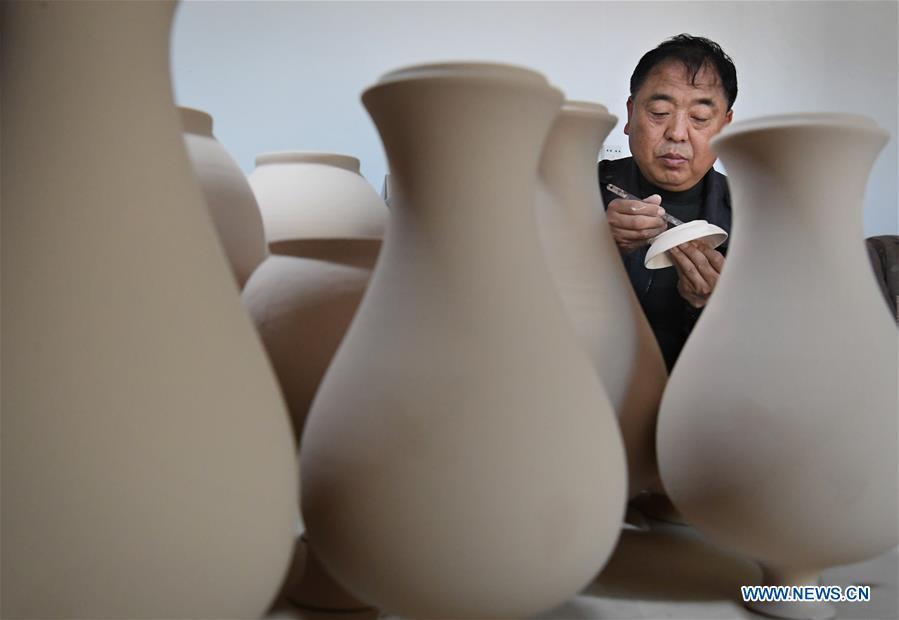
Wang Junzi makes a Ru porcelain work at his studio in Qingliangsi Village, Baofeng County of central China's Henan Province, May 8, 2019. Ru porcelain, one of the five famous kinds of porcelains during the Song Dynasty (960-1279) in ancient China, is known for its azure color, light body, filmy grain and gentle textile. Wang Junzi, born in 1960, is a Ru porcelain firing craftsman in Qingliangsi Village of Baofeng County in central China's Henan, where the ancient official Ru porcelain kiln in Song Dynasty is located. In order to reproduce the beauty of "celestial blue" of Ru porcelain, Wang Junzi has devoted himself to tackling the key problems for more than 30 years. Influenced by his family and the culture of Ru porcelain, Wang Junzi has devoted himself to studying Ru porcelain since young. In order to solve a series of technical problems such as the preparation of azure glaze, Wang Junzi went to many porcelain producing places for advice, and through thousands of experiments, finally grasped the key technology of Ru porcelain firing and formed unique technical characteristics. Now he has gained the unique skills of Ru porcelain firing and has become the representative inheritor of firing skills of Ru porcelain, a national intangible cultural heritage. In order to carry forward the culture of Ru porcelain and inherit its skills, Wang Junzi has successively accepted nearly 20 apprentices since 2003. He has taught young people the traditional technological processes and methods of firing Ru porcelain, such as manual casting, glaze ingredients preparing, glazing and firing. With his efforts, Ru porcelain culture has become a symbol for the development of local cultural industry. "My dream is to recover, pass on and carry forward the art of firing Ru porcelain." Said Wang Junzi. (Xinhua/Li An)
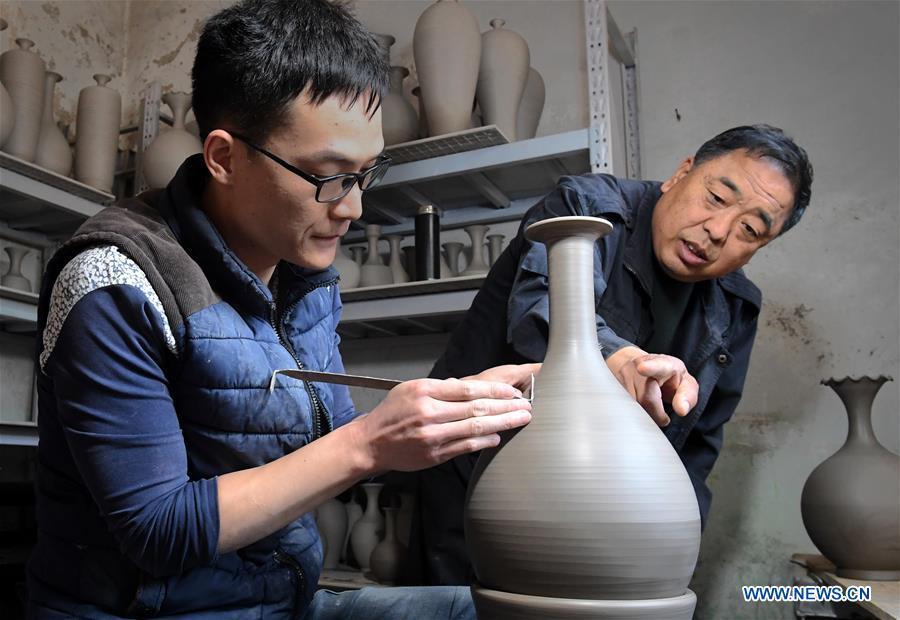
Wang Junzi guides his apprentice Li Jiabao at his studio in Qingliangsi Village, Baofeng County of central China's Henan Province, May 8, 2019. Ru porcelain, one of the five famous kinds of porcelains during the Song Dynasty (960-1279) in ancient China, is known for its azure color, light body, filmy grain and gentle textile. Wang Junzi, born in 1960, is a Ru porcelain firing craftsman in Qingliangsi Village of Baofeng County in central China's Henan, where the ancient official Ru porcelain kiln in Song Dynasty is located. In order to reproduce the beauty of "celestial blue" of Ru porcelain, Wang Junzi has devoted himself to tackling the key problems for more than 30 years. Influenced by his family and the culture of Ru porcelain, Wang Junzi has devoted himself to studying Ru porcelain since young. In order to solve a series of technical problems such as the preparation of azure glaze, Wang Junzi went to many porcelain producing places for advice, and through thousands of experiments, finally grasped the key technology of Ru porcelain firing and formed unique technical characteristics. Now he has gained the unique skills of Ru porcelain firing and has become the representative inheritor of firing skills of Ru porcelain, a national intangible cultural heritage. In order to carry forward the culture of Ru porcelain and inherit its skills, Wang Junzi has successively accepted nearly 20 apprentices since 2003. He has taught young people the traditional technological processes and methods of firing Ru porcelain, such as manual casting, glaze ingredients preparing, glazing and firing. With his efforts, Ru porcelain culture has become a symbol for the development of local cultural industry. "My dream is to recover, pass on and carry forward the art of firing Ru porcelain." Said Wang Junzi. (Xinhua/Li An)
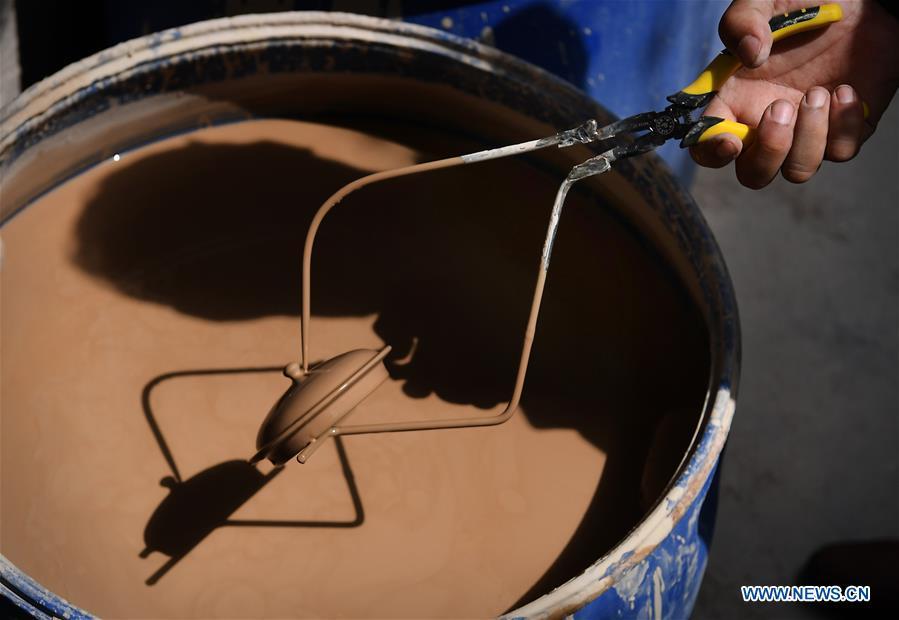
Wang Junzi glazes Ru porcelain work at his studio in Qingliangsi Village, Baofeng County of central China's Henan Province, May 8, 2019. Ru porcelain, one of the five famous kinds of porcelains during the Song Dynasty (960-1279) in ancient China, is known for its azure color, light body, filmy grain and gentle textile. Wang Junzi, born in 1960, is a Ru porcelain firing craftsman in Qingliangsi Village of Baofeng County in central China's Henan, where the ancient official Ru porcelain kiln in Song Dynasty is located. In order to reproduce the beauty of "celestial blue" of Ru porcelain, Wang Junzi has devoted himself to tackling the key problems for more than 30 years. Influenced by his family and the culture of Ru porcelain, Wang Junzi has devoted himself to studying Ru porcelain since young. In order to solve a series of technical problems such as the preparation of azure glaze, Wang Junzi went to many porcelain producing places for advice, and through thousands of experiments, finally grasped the key technology of Ru porcelain firing and formed unique technical characteristics. Now he has gained the unique skills of Ru porcelain firing and has become the representative inheritor of firing skills of Ru porcelain, a national intangible cultural heritage. In order to carry forward the culture of Ru porcelain and inherit its skills, Wang Junzi has successively accepted nearly 20 apprentices since 2003. He has taught young people the traditional technological processes and methods of firing Ru porcelain, such as manual casting, glaze ingredients preparing, glazing and firing. With his efforts, Ru porcelain culture has become a symbol for the development of local cultural industry. "My dream is to recover, pass on and carry forward the art of firing Ru porcelain." Said Wang Junzi. (Xinhua/Li An)
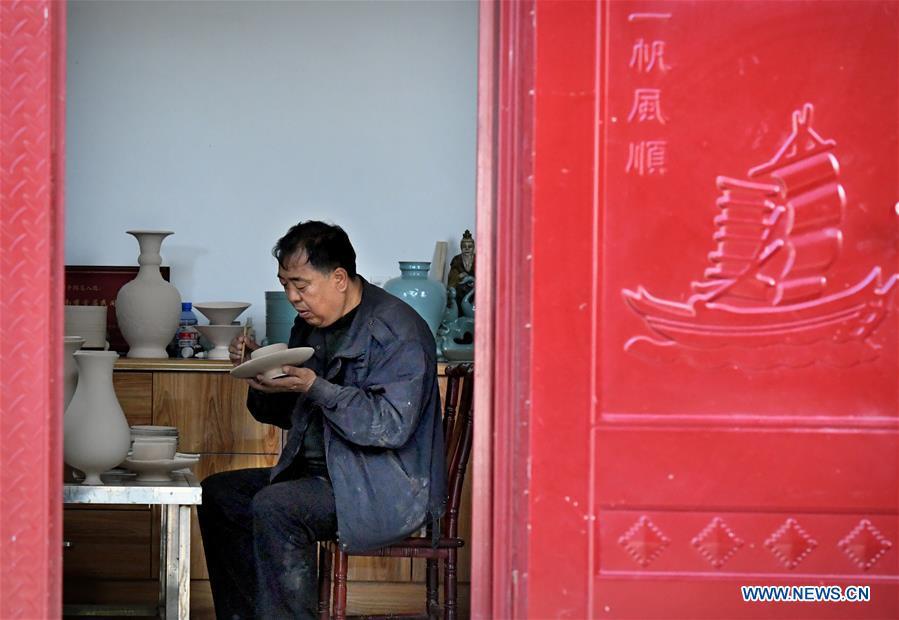
Wang Junzi makes a Ru porcelain work at his studio in Qingliangsi Village, Baofeng County of central China's Henan Province, May 8, 2019. Ru porcelain, one of the five famous kinds of porcelains during the Song Dynasty (960-1279) in ancient China, is known for its azure color, light body, filmy grain and gentle textile. Wang Junzi, born in 1960, is a Ru porcelain firing craftsman in Qingliangsi Village of Baofeng County in central China's Henan, where the ancient official Ru porcelain kiln in Song Dynasty is located. In order to reproduce the beauty of "celestial blue" of Ru porcelain, Wang Junzi has devoted himself to tackling the key problems for more than 30 years. Influenced by his family and the culture of Ru porcelain, Wang Junzi has devoted himself to studying Ru porcelain since young. In order to solve a series of technical problems such as the preparation of azure glaze, Wang Junzi went to many porcelain producing places for advice, and through thousands of experiments, finally grasped the key technology of Ru porcelain firing and formed unique technical characteristics. Now he has gained the unique skills of Ru porcelain firing and has become the representative inheritor of firing skills of Ru porcelain, a national intangible cultural heritage. In order to carry forward the culture of Ru porcelain and inherit its skills, Wang Junzi has successively accepted nearly 20 apprentices since 2003. He has taught young people the traditional technological processes and methods of firing Ru porcelain, such as manual casting, glaze ingredients preparing, glazing and firing. With his efforts, Ru porcelain culture has become a symbol for the development of local cultural industry. "My dream is to recover, pass on and carry forward the art of firing Ru porcelain." Said Wang Junzi. (Xinhua/Li An)
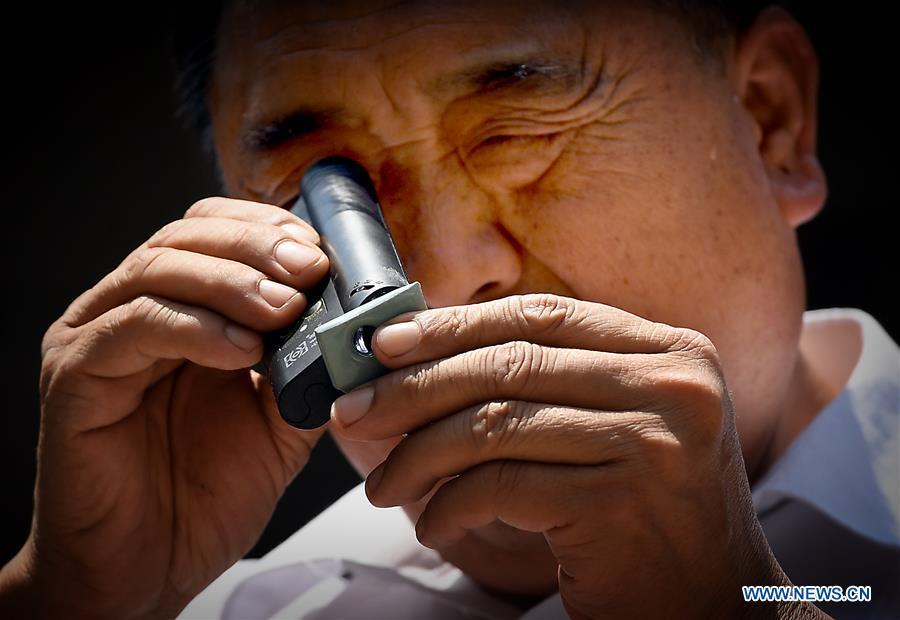
Wang Junzi checks the interior structure of a test porcelain piece at his studio in Qingliangsi Village, Baofeng County of central China's Henan Province, May 9, 2019. Ru porcelain, one of the five famous kinds of porcelains during the Song Dynasty (960-1279) in ancient China, is known for its azure color, light body, filmy grain and gentle textile. Wang Junzi, born in 1960, is a Ru porcelain firing craftsman in Qingliangsi Village of Baofeng County in central China's Henan, where the ancient official Ru porcelain kiln in Song Dynasty is located. In order to reproduce the beauty of "celestial blue" of Ru porcelain, Wang Junzi has devoted himself to tackling the key problems for more than 30 years. Influenced by his family and the culture of Ru porcelain, Wang Junzi has devoted himself to studying Ru porcelain since young. In order to solve a series of technical problems such as the preparation of azure glaze, Wang Junzi went to many porcelain producing places for advice, and through thousands of experiments, finally grasped the key technology of Ru porcelain firing and formed unique technical characteristics. Now he has gained the unique skills of Ru porcelain firing and has become the representative inheritor of firing skills of Ru porcelain, a national intangible cultural heritage. In order to carry forward the culture of Ru porcelain and inherit its skills, Wang Junzi has successively accepted nearly 20 apprentices since 2003. He has taught young people the traditional technological processes and methods of firing Ru porcelain, such as manual casting, glaze ingredients preparing, glazing and firing. With his efforts, Ru porcelain culture has become a symbol for the development of local cultural industry. "My dream is to recover, pass on and carry forward the art of firing Ru porcelain." Said Wang Junzi. (Xinhua/Li An)
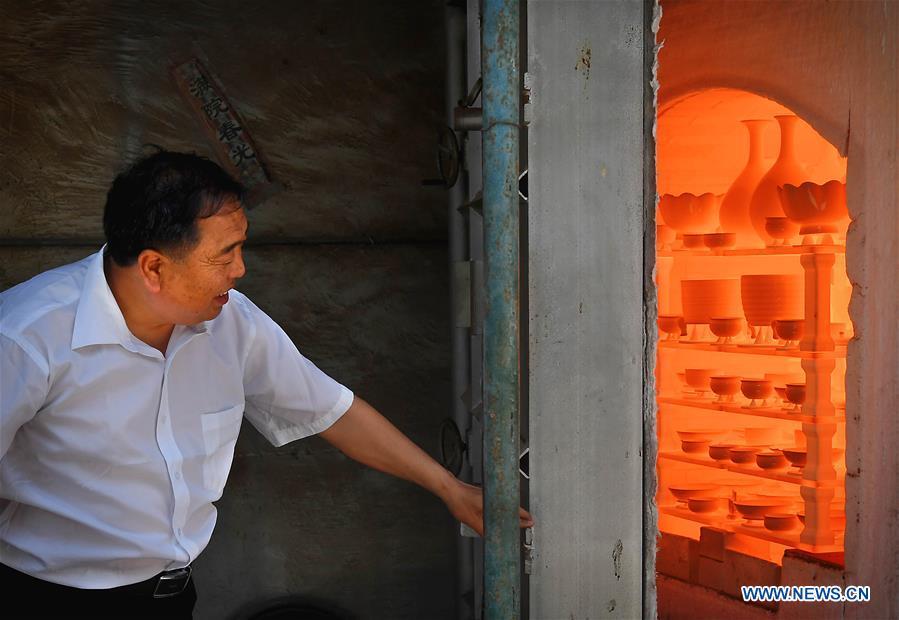
Wang Junzi opens Ru porcelain kiln at his studio in Qingliangsi Village, Baofeng County of central China's Henan Province, May 9, 2019. Ru porcelain, one of the five famous kinds of porcelains during the Song Dynasty (960-1279) in ancient China, is known for its azure color, light body, filmy grain and gentle textile. Wang Junzi, born in 1960, is a Ru porcelain firing craftsman in Qingliangsi Village of Baofeng County in central China's Henan, where the ancient official Ru porcelain kiln in Song Dynasty is located. In order to reproduce the beauty of "celestial blue" of Ru porcelain, Wang Junzi has devoted himself to tackling the key problems for more than 30 years. Influenced by his family and the culture of Ru porcelain, Wang Junzi has devoted himself to studying Ru porcelain since young. In order to solve a series of technical problems such as the preparation of azure glaze, Wang Junzi went to many porcelain producing places for advice, and through thousands of experiments, finally grasped the key technology of Ru porcelain firing and formed unique technical characteristics. Now he has gained the unique skills of Ru porcelain firing and has become the representative inheritor of firing skills of Ru porcelain, a national intangible cultural heritage. In order to carry forward the culture of Ru porcelain and inherit its skills, Wang Junzi has successively accepted nearly 20 apprentices since 2003. He has taught young people the traditional technological processes and methods of firing Ru porcelain, such as manual casting, glaze ingredients preparing, glazing and firing. With his efforts, Ru porcelain culture has become a symbol for the development of local cultural industry. "My dream is to recover, pass on and carry forward the art of firing Ru porcelain." Said Wang Junzi. (Xinhua/Li An)
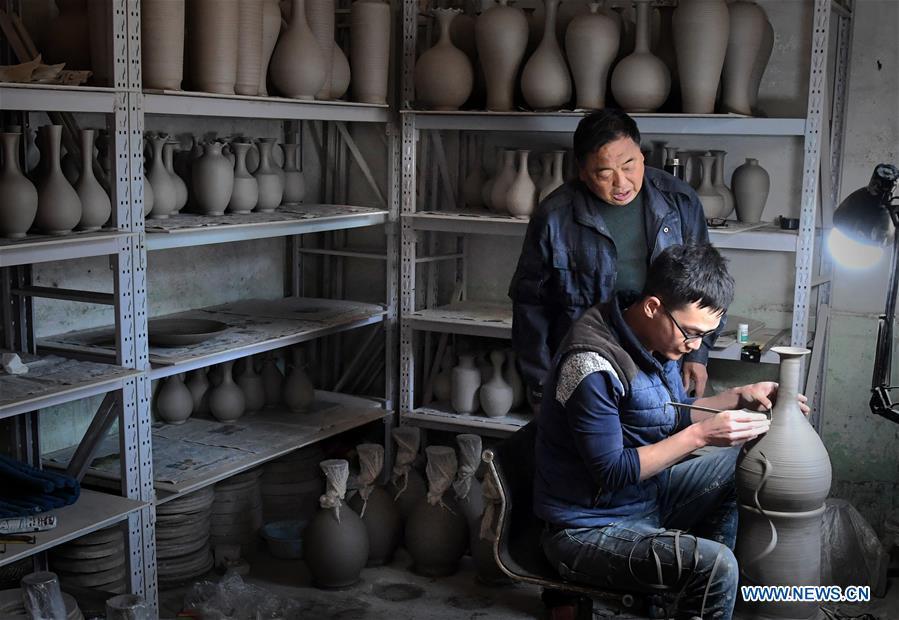
Wang Junzi guides his apprentice Li Jiabao at his studio in Qingliangsi Village, Baofeng County of central China's Henan Province, May 8, 2019. Ru porcelain, one of the five famous kinds of porcelains during the Song Dynasty (960-1279) in ancient China, is known for its azure color, light body, filmy grain and gentle textile. Wang Junzi, born in 1960, is a Ru porcelain firing craftsman in Qingliangsi Village of Baofeng County in central China's Henan, where the ancient official Ru porcelain kiln in Song Dynasty is located. In order to reproduce the beauty of "celestial blue" of Ru porcelain, Wang Junzi has devoted himself to tackling the key problems for more than 30 years. Influenced by his family and the culture of Ru porcelain, Wang Junzi has devoted himself to studying Ru porcelain since young. In order to solve a series of technical problems such as the preparation of azure glaze, Wang Junzi went to many porcelain producing places for advice, and through thousands of experiments, finally grasped the key technology of Ru porcelain firing and formed unique technical characteristics. Now he has gained the unique skills of Ru porcelain firing and has become the representative inheritor of firing skills of Ru porcelain, a national intangible cultural heritage. In order to carry forward the culture of Ru porcelain and inherit its skills, Wang Junzi has successively accepted nearly 20 apprentices since 2003. He has taught young people the traditional technological processes and methods of firing Ru porcelain, such as manual casting, glaze ingredients preparing, glazing and firing. With his efforts, Ru porcelain culture has become a symbol for the development of local cultural industry. "My dream is to recover, pass on and carry forward the art of firing Ru porcelain." Said Wang Junzi. (Xinhua/Li An)
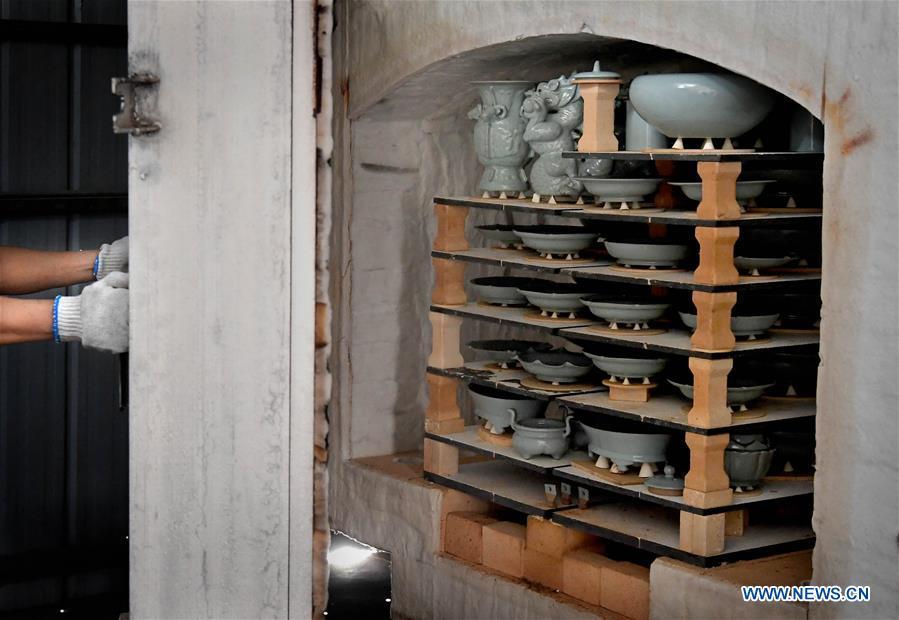
Wang Junzi opens Ru porcelain kiln at his studio in Qingliangsi Village, Baofeng County of central China's Henan Province, May 9, 2019. Ru porcelain, one of the five famous kinds of porcelains during the Song Dynasty (960-1279) in ancient China, is known for its azure color, light body, filmy grain and gentle textile. Wang Junzi, born in 1960, is a Ru porcelain firing craftsman in Qingliangsi Village of Baofeng County in central China's Henan, where the ancient official Ru porcelain kiln in Song Dynasty is located. In order to reproduce the beauty of "celestial blue" of Ru porcelain, Wang Junzi has devoted himself to tackling the key problems for more than 30 years. Influenced by his family and the culture of Ru porcelain, Wang Junzi has devoted himself to studying Ru porcelain since young. In order to solve a series of technical problems such as the preparation of azure glaze, Wang Junzi went to many porcelain producing places for advice, and through thousands of experiments, finally grasped the key technology of Ru porcelain firing and formed unique technical characteristics. Now he has gained the unique skills of Ru porcelain firing and has become the representative inheritor of firing skills of Ru porcelain, a national intangible cultural heritage. In order to carry forward the culture of Ru porcelain and inherit its skills, Wang Junzi has successively accepted nearly 20 apprentices since 2003. He has taught young people the traditional technological processes and methods of firing Ru porcelain, such as manual casting, glaze ingredients preparing, glazing and firing. With his efforts, Ru porcelain culture has become a symbol for the development of local cultural industry. "My dream is to recover, pass on and carry forward the art of firing Ru porcelain." Said Wang Junzi. (Xinhua/Li An)
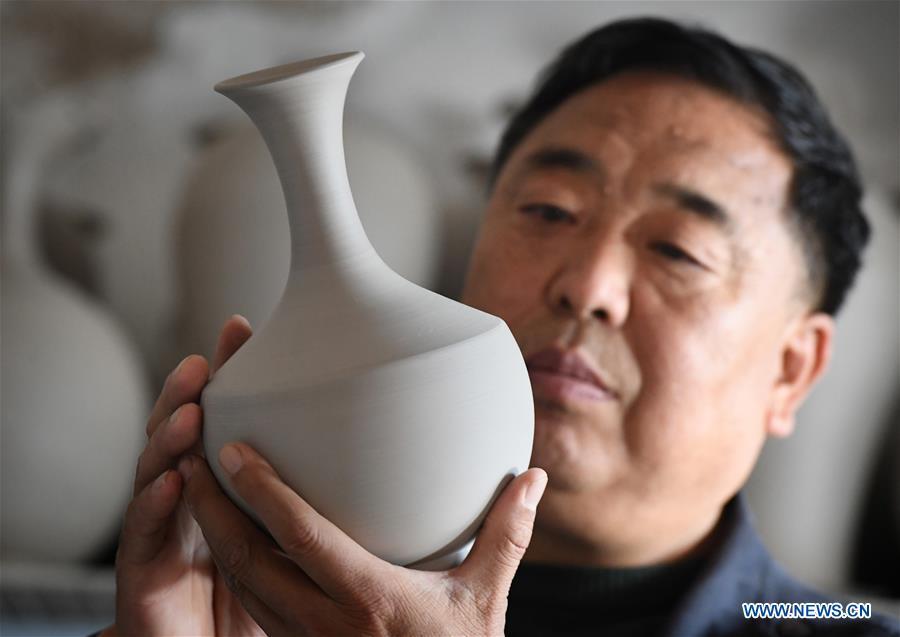
Wang Junzi checks a Ru porcelain work at his studio in Qingliangsi Village, Baofeng County of central China's Henan Province, May 8, 2019. Ru porcelain, one of the five famous kinds of porcelains during the Song Dynasty (960-1279) in ancient China, is known for its azure color, light body, filmy grain and gentle textile. Wang Junzi, born in 1960, is a Ru porcelain firing craftsman in Qingliangsi Village of Baofeng County in central China's Henan, where the ancient official Ru porcelain kiln in Song Dynasty is located. In order to reproduce the beauty of "celestial blue" of Ru porcelain, Wang Junzi has devoted himself to tackling the key problems for more than 30 years. Influenced by his family and the culture of Ru porcelain, Wang Junzi has devoted himself to studying Ru porcelain since young. In order to solve a series of technical problems such as the preparation of azure glaze, Wang Junzi went to many porcelain producing places for advice, and through thousands of experiments, finally grasped the key technology of Ru porcelain firing and formed unique technical characteristics. Now he has gained the unique skills of Ru porcelain firing and has become the representative inheritor of firing skills of Ru porcelain, a national intangible cultural heritage. In order to carry forward the culture of Ru porcelain and inherit its skills, Wang Junzi has successively accepted nearly 20 apprentices since 2003. He has taught young people the traditional technological processes and methods of firing Ru porcelain, such as manual casting, glaze ingredients preparing, glazing and firing. With his efforts, Ru porcelain culture has become a symbol for the development of local cultural industry. "My dream is to recover, pass on and carry forward the art of firing Ru porcelain." Said Wang Junzi. (Xinhua/Li An)












